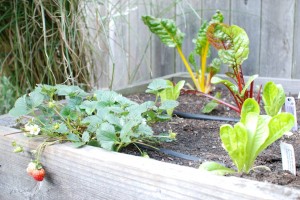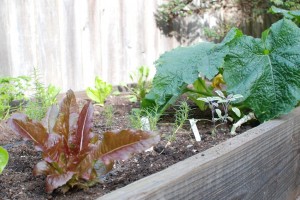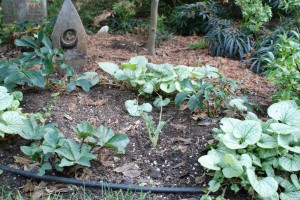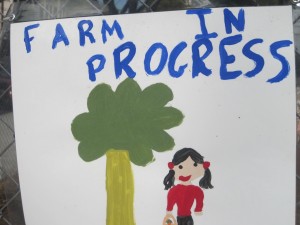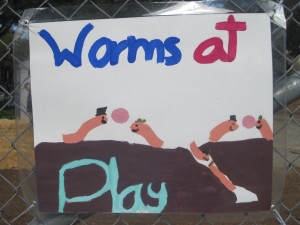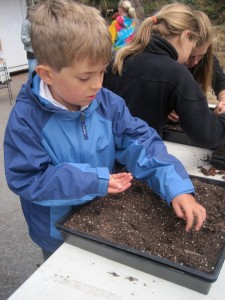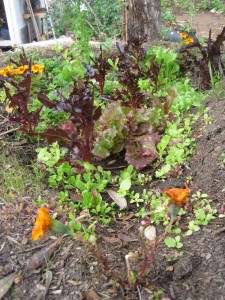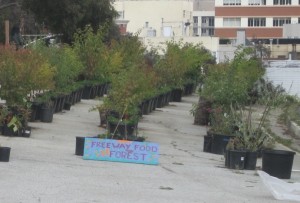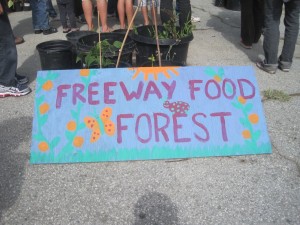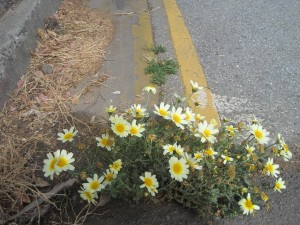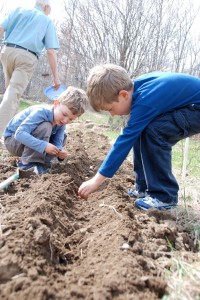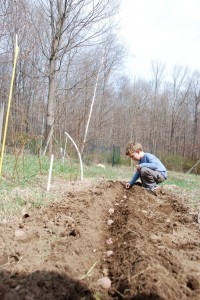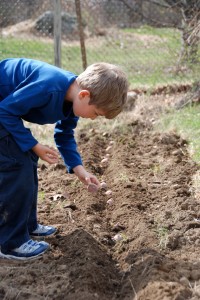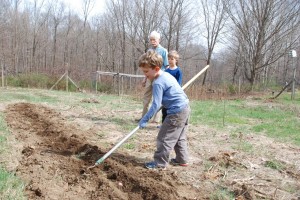These are not the padrones we usually eat all summer long, but ones we actually grew in our garden. They were perfect. If the plants actually start producing, this will save us at least $6 a week. A girl can dream, can’t she?
gardening with kids
Hayes Valley Farm
by Caroline
A lifetime ago, pre-husband and pre-kids, I lived in the not-yet-gentrified Hayes Valley neighborhood of San Francisco. My top floor apartment looked out over a vacant lot which had once been shadowed by the 101 freeway off-ramp, but after the Loma Prieta earthquake damaged the road, the ramp was torn down and the lot — in all its weedy, broken-asphalt ugliness — was exposed to new light. The weeds started growing denser and scrubby trees started to sprout; the lot was surrounded by chain link fence, but that didn’t stop people from camping in it. I used to sit in my window looking out over the space, wondering if the city would ever pay attention to the lot and make better use of the area.
The rest of the neighborhood started improving; hip shops and cafes moved in, and although I moved away, I’d drive past frequently on my drive to graduate school in Berkeley. Eventually a sign went up on the chain link fence, announcing a condo development, but nothing happened. Then last winter, a new sign went up, and then lots of new signs:
We had to go see it.
We love to visit farms. We tend our own little garden in the backyard and for inspiration we have visited farms on the prairie and on the coast and even one tucked behind a suburban development.
I discovered that when the condo development plans fell victim to the recession, the city opened the site up for “temporary green space use” and the community has taken it from there. On our visit, one group of folks sorted through packets of donated lettuce seed to plant out in flats:
We planted some of it in flats ourselves:
And we admired the healthy salad bar that’s growing from seeds planted earlier in the season:
We saw another group sorting and stacking cardboard, some of the over 80,000 pounds the farmers have used already to create the farm’s “soil” out of layered cardboard, wood chips, and horse manure:
The ingredients for soil (like the seeds) are donated; the community farmers collect the cardboard, wood chips and manure free and with the city’s thanks, from the local waste stream.
These folks are serious about their farming. They are developing dwarf fruit trees that thrive in pots, so that apartment dwellers can harvest their own apples and pears:
They are refining potato columns, which grow in simple, portable chicken wire towers and yield lovely potatoes that my kids couldn’t resist harvesting:
“It’s really not scary to grow food,” commented our tour guide; indeed, for all their innovations here, they are also doing some things in ancient ways, studying the terraced farms of the Incas because San Francisco’s climate mirrors that of the Andes mountains.
The farmers are making it fun, too, hosting volunteer work parties followed by free yoga sessions, movie nights and picnics, plus classes on topics ranging from medicinal plants to soil health to permaculture to emergency preparedness. “The main thing we’re growing is a community,” our guide commented, and it’s growing beautifully. It’s like turning swords into plowshares: the Hayes Valley volunteers are farming the freeway:
Planting Potatoes
by Caroline
Last summer when we visited my parents, the boys experienced the treasure hunt of digging potatoes. This spring, to bring the process full circle (backwards!) they planted. Both boys have done a fair amount of seed planting, both at home and at school, and Eli’s recent picture demonstrates some understanding of the process:
But potatoes are different. They don’t grow from seeds. And since we don’t have the space nor the climate for potatoes here, I’m grateful that my kids could head out to the garden with my dad for a brief farm lesson in the dirt.
I was stuck inside on crutches on the day they planted, so I have no story to relate about the event, but my sympathetic husband took some lovely pictures (you can click on them to enlarge):
One City Garden
by Caroline
I grew up in a little town (it calls itself a village, and while I find the word a little precious, it fits) of big, pretty houses on smallish lawns. The yards weren’t fenced, and my neighborhood didn’t have sidewalks, which made it a pretty soft place for a kid to grow up running around with her friends, racing from one yard to the next as our game developed. Our yard was part of the action, too, until my dad realized that the front got a lot more direct sun than the backyard, and so that’s where the vegetable garden went. Screened by a pretty hedge of deep pink and white beach roses, the garden produced peas, beans, tomatoes, broccoli and lettuce, among other vegetables. My dad established another small garden next to the side door and encouraged a patch of blackberries at the end of the driveway. Volunteer squash and tomatoes sprang up from the compost pile and, as my siblings and I grew up and needed less yard to play in, Dad cultivated gradually larger swaths of the backyard, too.
Now my parents have retired to a big piece of property in rural Connecticut, where my dad has an enormous garden and orchard, and I’m the one with an urban garden. Now, this is not the kind of really urban gardening that Lisa wrote about last summer. We don’t have a front yard here in San Francisco, but we can at least do our planting in the ground, not a truck (though honestly, my kids would prefer a truck).
For now, while my children are young and require a lot of my attention for their cultivation, we’re keeping the garden small. (A friend, whose youngest child is the age of my oldest, has recently converted her entire backyard into an edible space; no lawn at all, just paths made and lined with herbs, blueberry bushes and fruit trees in sunny spots along the fences, vegetables — some in beds, some (like the artichokes) standing alone — sprouting up in every spare nook. I dream of such a yard, someday). We’re still learning what we can
produce here in our foggy neighborhood; we don’t get a lot of heat or sun, but we have a pretty long growing season; greens do very well, tomatoes do not. And whenever one of my kids has an urge to plant a seed, I encourage the impulse even if I know, as with yesterday’s apple seed, it’s not likely to bear edible fruit. Some times, it’s important simply to plant a seed.

